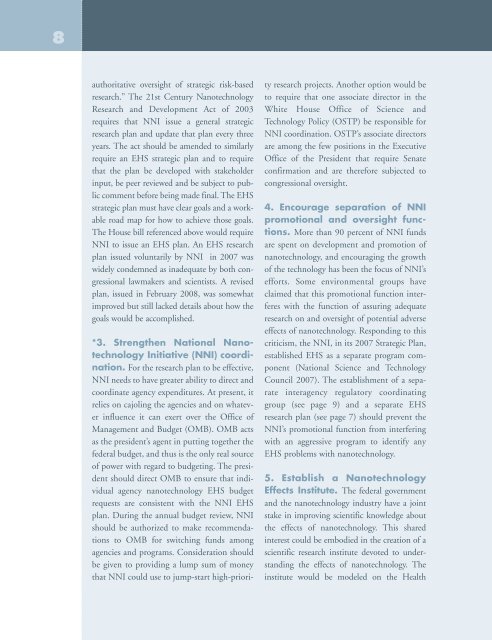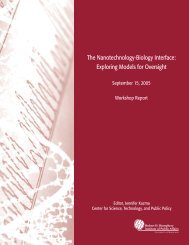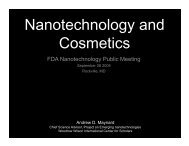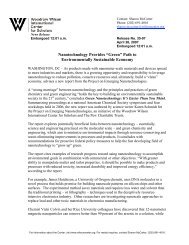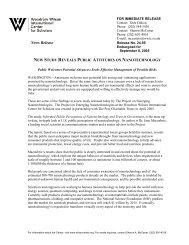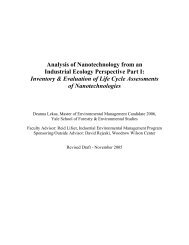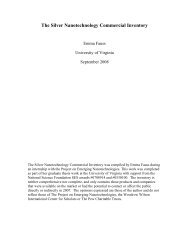nanotechnology oversight - Project on Emerging Nanotechnologies
nanotechnology oversight - Project on Emerging Nanotechnologies
nanotechnology oversight - Project on Emerging Nanotechnologies
Create successful ePaper yourself
Turn your PDF publications into a flip-book with our unique Google optimized e-Paper software.
8<br />
authoritative <str<strong>on</strong>g>oversight</str<strong>on</strong>g> of strategic risk-based<br />
research.” The 21st Century Nanotechnology<br />
Research and Development Act of 2003<br />
requires that NNI issue a general strategic<br />
research plan and update that plan every three<br />
years. The act should be amended to similarly<br />
require an EHS strategic plan and to require<br />
that the plan be developed with stakeholder<br />
input, be peer reviewed and be subject to public<br />
comment before being made final. The EHS<br />
strategic plan must have clear goals and a workable<br />
road map for how to achieve those goals.<br />
The House bill referenced above would require<br />
NNI to issue an EHS plan. An EHS research<br />
plan issued voluntarily by NNI in 2007 was<br />
widely c<strong>on</strong>demned as inadequate by both c<strong>on</strong>gressi<strong>on</strong>al<br />
lawmakers and scientists. A revised<br />
plan, issued in February 2008, was somewhat<br />
improved but still lacked details about how the<br />
goals would be accomplished.<br />
*3. Strengthen Nati<strong>on</strong>al Nanotechnology<br />
Initiative (NNI) coordinati<strong>on</strong>.<br />
For the research plan to be effective,<br />
NNI needs to have greater ability to direct and<br />
coordinate agency expenditures. At present, it<br />
relies <strong>on</strong> cajoling the agencies and <strong>on</strong> whatever<br />
influence it can exert over the Office of<br />
Management and Budget (OMB). OMB acts<br />
as the president’s agent in putting together the<br />
federal budget, and thus is the <strong>on</strong>ly real source<br />
of power with regard to budgeting. The president<br />
should direct OMB to ensure that individual<br />
agency <str<strong>on</strong>g>nanotechnology</str<strong>on</strong>g> EHS budget<br />
requests are c<strong>on</strong>sistent with the NNI EHS<br />
plan. During the annual budget review, NNI<br />
should be authorized to make recommendati<strong>on</strong>s<br />
to OMB for switching funds am<strong>on</strong>g<br />
agencies and programs. C<strong>on</strong>siderati<strong>on</strong> should<br />
be given to providing a lump sum of m<strong>on</strong>ey<br />
that NNI could use to jump-start high-priority<br />
research projects. Another opti<strong>on</strong> would be<br />
to require that <strong>on</strong>e associate director in the<br />
White House Office of Science and<br />
Technology Policy (OSTP) be resp<strong>on</strong>sible for<br />
NNI coordinati<strong>on</strong>. OSTP’s associate directors<br />
are am<strong>on</strong>g the few positi<strong>on</strong>s in the Executive<br />
Office of the President that require Senate<br />
c<strong>on</strong>firmati<strong>on</strong> and are therefore subjected to<br />
c<strong>on</strong>gressi<strong>on</strong>al <str<strong>on</strong>g>oversight</str<strong>on</strong>g>.<br />
4. Encourage separati<strong>on</strong> of NNI<br />
promoti<strong>on</strong>al and <str<strong>on</strong>g>oversight</str<strong>on</strong>g> functi<strong>on</strong>s.<br />
More than 90 percent of NNI funds<br />
are spent <strong>on</strong> development and promoti<strong>on</strong> of<br />
<str<strong>on</strong>g>nanotechnology</str<strong>on</strong>g>, and encouraging the growth<br />
of the technology has been the focus of NNI’s<br />
efforts. Some envir<strong>on</strong>mental groups have<br />
claimed that this promoti<strong>on</strong>al functi<strong>on</strong> interferes<br />
with the functi<strong>on</strong> of assuring adequate<br />
research <strong>on</strong> and <str<strong>on</strong>g>oversight</str<strong>on</strong>g> of potential adverse<br />
effects of <str<strong>on</strong>g>nanotechnology</str<strong>on</strong>g>. Resp<strong>on</strong>ding to this<br />
criticism, the NNI, in its 2007 Strategic Plan,<br />
established EHS as a separate program comp<strong>on</strong>ent<br />
(Nati<strong>on</strong>al Science and Technology<br />
Council 2007). The establishment of a separate<br />
interagency regulatory coordinating<br />
group (see page 9) and a separate EHS<br />
research plan (see page 7) should prevent the<br />
NNI’s promoti<strong>on</strong>al functi<strong>on</strong> from interfering<br />
with an aggressive program to identify any<br />
EHS problems with <str<strong>on</strong>g>nanotechnology</str<strong>on</strong>g>.<br />
5. Establish a Nanotechnology<br />
Effects Institute. The federal government<br />
and the <str<strong>on</strong>g>nanotechnology</str<strong>on</strong>g> industry have a joint<br />
stake in improving scientific knowledge about<br />
the effects of <str<strong>on</strong>g>nanotechnology</str<strong>on</strong>g>. This shared<br />
interest could be embodied in the creati<strong>on</strong> of a<br />
scientific research institute devoted to understanding<br />
the effects of <str<strong>on</strong>g>nanotechnology</str<strong>on</strong>g>. The<br />
institute would be modeled <strong>on</strong> the Health


